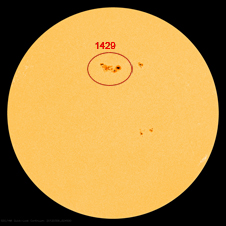 Every day our Earth experiences storms of all kinds including one type of storm that we often don’t realize we are experiencing — a solar storm. Thanks to our protective atmosphere and magnetic field called the magnetosphere, we’re safe from the dangers of solar storms.
Every day our Earth experiences storms of all kinds including one type of storm that we often don’t realize we are experiencing — a solar storm. Thanks to our protective atmosphere and magnetic field called the magnetosphere, we’re safe from the dangers of solar storms.
On March 10, 2012, the sun released another two M-class flares. One, rated as an M5.4, peaked at 12:27 a.m. EST. The second, rated as an M 8.4, peaked at 12:44 p.m. EST.These two flares came from the same active region on the sun, designated number 1429, that has already produced three X-class and numerous M-class flares over the past week.
On March 8, 2012 at 10:53 p.m. EST the sun erupted with an M6.3 class flare, and about an hour later released a coronal mass ejection or CME. These eruptions came from active region 1429 that has so far produced two X class flares, and numerous M-class flares.
NASA’s Space Weather Center models measure the CME traveling at speeds of over 700 miles per second.
